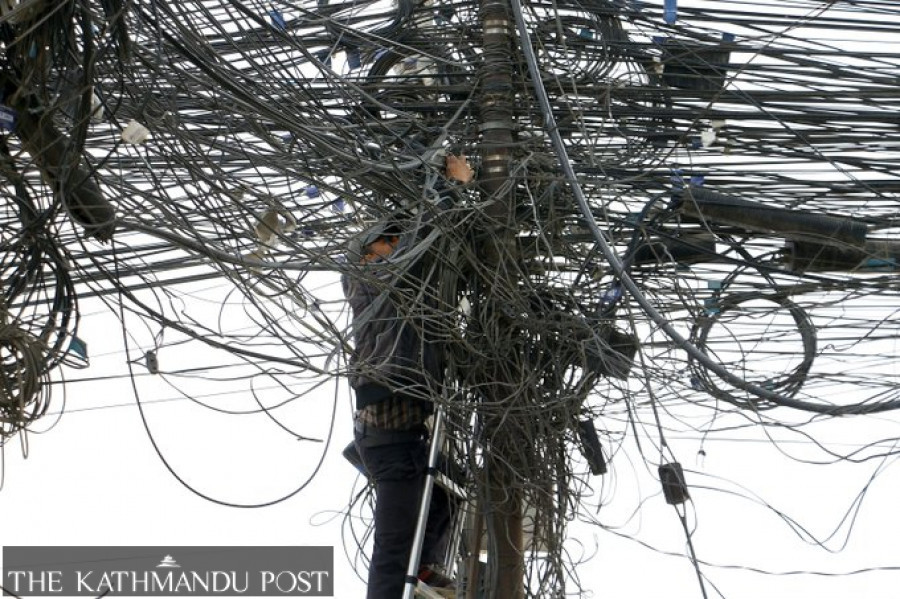Kathmandu
Kathmandu metropolis clears nearly 100 tonnes of cable clutter from utility poles
With the KMC unclear about what to do with the mess, the Teku space is filling up.
Anup Ojha
The Kathmandu Metropolitan City started removing the tangled mess of overhead cables with much fanfare over a month ago, aiming to beautify the city. But the City is still unclear about what to do with the collected mess that is likely to weigh hundreds of tonnes by the time the campaign is completed.
Officials said that since the drive kicked off on May 8, the City has in a month collected over 50 truckloads of cables, which would be around 97 tonnes. The collected cables have all been dumped in an open area at the waste transfer station in Teku.
“We still don’t have a plan as to what to do with the cables,” Raju Nath Pandey, chief of the municipal police, said, adding that since nobody has shown an interest in buying or taking away the collected cables, managing them has become a ‘headache’ for the City. “We have yet to remove hundreds of tonnes of tangled wires from poles, and we might soon run out of space at the Teku waste transfer station.”
As matters stand, keeping all of the removed cables in Teku is a risky proposition.
Last year, in May, a massive fire had broken out at the same place the City is dumping the cables.
“If the heap of cables at Teku catches fire, we won’t be able to douse it,” said Deputy Inspector of the municipal police Min Bahadur Thapa, who looks after solid waste management at the Teku waste transfer station.
He said that at present two city policemen have been deployed at Teku to guard the collected cables.
KMC officials said that earlier, during the tenure of former mayor Bidya Sundar Shakya, the City would give away the collected unwanted cables to brick kilns in Bhaktapur. A City official who didn’t want to be named for fears of reprisal hinted that the KMC is keeping that option open.
Urban planners and environmentalists, however, say the City should not give those cables for brick kilns to burn, given the attendant risks of the move.
“The Valley already has hazardous air quality, and if the City sells the discarded cables to brick kilns, it will be devastating,” said Suman Meher Shrestha, an urban planner.
The Kathmandu Valley has received the ignominy of being the world’s most polluted city multiple times with traditional brick kilns being the major contributors to it.
Bhushan Tuladhar, an environmentalist who closely follows urban issues including pollution, said the City could recycle the dumped cables. “If the City opts to recycle the cables, it might incur some cost, but it will be the best way out,” said Tuladhar.
He, too, said the KMC should not give the cables away to brick kilns. The plastic-covered wires when burnt emit toxic smoke that will exacerbate the air pollution, he said.
A World Bank Report in 2020 showed that traditional brick kilns continue to pollute air, take lives and cause huge financial losses.
“Right now Rabin Man Shrestha, chief of the Environment Department, is in Japan. But once he is back, he will make a decision,” said Thapa.
Meanwhile, assistant spokesman at the City, Deepak Adhikari, too, conceded the City’s inability to manage the cables. He said that earlier, the City had planned to give the cables to vegetable farmers to make frames for their plastic tunnels, but knowing its environmental effect as the cable coverings are not biodegradable, the City backtracked.
“This is going to be a serious challenge, so we are going to discuss the issue at our board meeting,” Adhikari said. “We may come up with some solution from there.”
Meanwhile, taking to social media on May 5, Kathmandu Mayor Balendra Shah had expressed his dissatisfaction at the lack of support from government ministries and internet service providers, in his efforts to remove the unwanted cables.
After Shah wrote on social media that the City may unilaterally move ahead with its plans to remove the tangled cables, cable operators had joined the City’s initiative.
“The mayor’s intention is good but he should have made a proper plan for the disposal of the cable’s mess before starting the drive,” said planner Shrestha. “This drive may help control the visual pollution, but if not managed well, this will create another problem. Either the City can recycle those cables or find some other creative solution, but starting a job without any forward plan shows immaturity.”
Until Tuesday, the City had collected unwanted cable wires from Maitighar to New Baneshwar and Thapathali to Tripureshwar, right up to Jamal. The City has also managed to clean the tangled cables from Ason and Indrachowk.
For its drive, the City has deployed 25 municipal police personnel in five different places where about 50 people from internet service providers have been working to remove the cables.
Officials say that it will take a minimum of three months to remove all the unwanted cables in the Kathmandu Metropolitan City.




 10.12°C Kathmandu
10.12°C Kathmandu.jpg)











